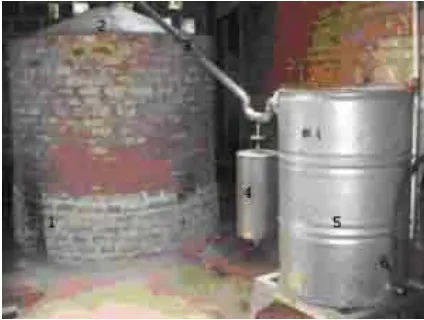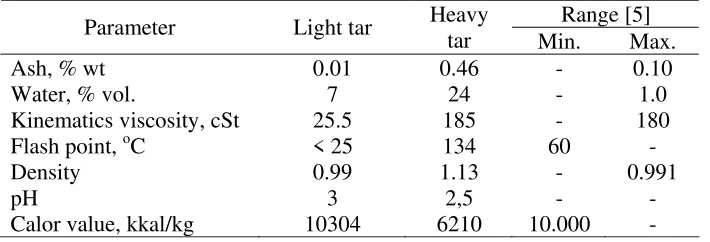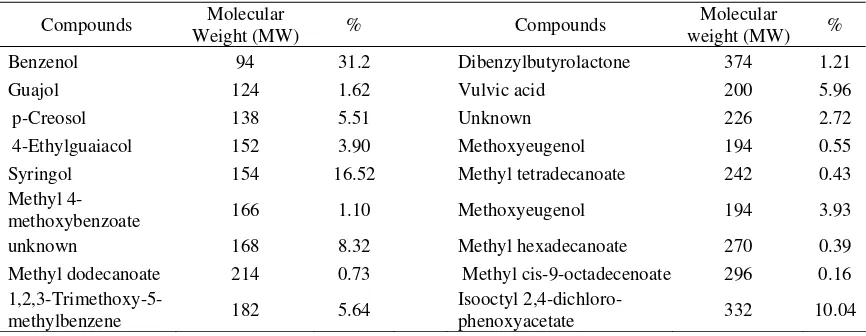The journal homepage www.jpacr.ub.ac.id ISSN : 2302‐4690
26
The Chemical Composition and Physical Properties of the Light
and Heavy Tar Resulted from Coconut Shell Pyrolysis
Uswatun Hasanah,1,2* Bambang Setiaji,2 Triyono,2 and Chairil Anwar2
1
Department of Chemistry, Faculty of Mathematics and Natural Sciences, University of Brawijaya; Jl. Veteran 65145 Malang, Indonesia
2
Postgraduate Program, Department of Chemistry, Faculty of Mathematics and Natural Sciences, Gadjah Mada University, Yogyakarta
E-mail contact: [email protected]
Received 28 May 2012; Accepted 3 June 2012
ABSTRACT
The tar resulted from pyrolysis of coconut shell is a waste. It is important to be clarified their chemical composition and physical properties in order to find out their feasibility as source of a fuel. This research was resulted two immiscible organic fractions, and these were further determined their physical properties such as water composition by using ASTM D-95 methods, ash composition (ASTM D-482), flash point C.O.C (ASTM D-92), kinematics of viscosity (ASTM D-445), and caloric valued using bomb calorimetric. In addition, tar composition was determined by gas chromatography-mass spectrometry (GCMS). The result provided oil which was categorized as light and heavy bio-oils. The light bio-oil has specific gravity 0.99, ash content 0.01%, kinematics viscosity 25.5 cSt, flash point <27 oC, pH 3 and heating value 10304 kcal/kg. On the other hand, heavy bio-oils gave specific gravity 1.13, ash 0.46%, kinematics viscosity 185 cSt, flash point 134 oC, pH 2.5 and heating value 6210 kcal/kg. Moreover, the light bio-oil contained 79 compounds which was composed of phenol 16.4%, hydrocarbon 12.4%, phenolic 27.6%, other oxygenated compounds 53.6%, and acetic acid 3%, meanwhile the heavy bio-oils contained of 18 compounds which was consisted of phenol 31.2%, lauric acid 6.0%, phenolic 27.6%, and other oxygenated compounds 35.3%, respectively. With this result, it was clarify that these bio-oils could not be used directly as a fuel for motor nor diesel machinery.
Key words: tar composition, physical properties of fuel, coconut shell, pyrolysis
INTRODUCTION
The technology of pyrolysis has been used by local community since a long time ago, and conventionally has been applied to produce a solid carbon. Recently, this method has paid many attentions for development such as by using condensation to afford liquid smoke besides the solid carbon. The physical properties and composition of this liquid smoke depend on the type of biomass, methods and the pyrolysis conditions such as temperature, leaving time of steam, rate of increasing temperature pyrolysis. The conventional pyrolysis, usually applied temperature is roughly 500 oC, leaving time of the steam between 5 and 30 minute, and using atmospheric pressure. The steam did not directly flow out such as in quick pyrolysis. This condition is able to initiate the reaction further within each steam component to provide a solid carbon and liquid smoke [1].
The journal homepage www.jpacr.ub.ac.id ISSN : 2302‐4690
27
applied of a range temperature. The different of reactivity from each component cause competition during decomposition process [2]. The process-condition optimum for a slow pyrolysis of coconut shell using constant fire was at 550 oC, heating rate 60 oC per minute, and provided liquid smoke maximum 45% [3]. The resulted chemical composition of liquid smoke was a mixture, mostly contained water, carboxylic acids, carbohydrate, and the derivative of lignin. In addition, the oils resulted also slightly acidic, viscous, reactive, and thermally unstable. Their chemical composition and physical properties was much different to the petroleum based-oils. This result, in order to direct application as motor fuel still requires specifics attentions and further research.
The standard as a fuel usually following the American Society for Testing and Material (ASTM) grade, and the standard of fuel resulted from biomass pyrolysis until recent time was not determined yet. Because the variation composition and physical properties of the liquid smoke, and also the pyrolysis methods still under going development. As consequence, application this liquid smoke resulted from biomass pyrolysis still require along study to find out a standard and properties as a fuel [4].
Pyrolysis of coconut shell by local community usually was conducted at 350 oC under atmosphere pressure and afforded solid carbon, liquid fraction or liquid smoke, organical fraction (tar), and gas. Economically, the solid carbon produced usually could be convert to afford activated carbon and bricket. Meanwhile liquid smoke commonly used as a food preservant, and increase latex acidity. The gas resulted could also be recycle directly as fuel for pyrolysis. But, tar product has no further application.
EXPERIMENT
The sample of tar was afforded from direct pyrolysis of coconut shell (150 kg), conditions: 250 – 300 oC, 5-6 h pyrolysis, at atmosphere pressure. Smoke resulted was condensed and further distillated to afford two layers product. After left overnight, this layer afforded upper layer (liquid smoke) and bottom organic layer (light tar), and residue as a heavy tar.
The journal homepage www.jpacr.ub.ac.id ISSN : 2302‐4690
28
Determination physical properties and chemical composition
The light and heavy tar was determined their physical properties, including water content (ASTM D-95), ash content (ASTM D-482), flash point C.O.C (ASTM D-95), kinematics viscosity (ASTM D-445), calor value (bomb calorymetry). Chemical composition was determined with GCMS (Shimadzu QP2010S, column Rtx-5MS, 30 meter, internal diameter 0.25 mm, carrier gas helium, oven 70 oC, injection temperature 310 oC, pressure 13.7 kPa, total flow 40.0 mL/min, colomn flow 0.50 mL/min, purge flow 3,0 mL/min and split ratio 72.9).
RESULT AND DISCUSSION
Physical properties of light and heavy tar
The physical properties of tar as a fuel were determined using the methods for analysis of petroleum oil according to the recommendation of Oasmaa and Peacocke (2010) [9]. Result for determination of light and heavy tar was presented in Table 1.
Table 1. Physical properties of tar from coconut shell pyrolysis
Range [5] Parameter Light tar Heavy
tar Min. Max.
The ash content of heavy tar indicated higher than the value of the light tar (Table 1), and this result also much higher than the maximum ash content which was recommended by Directorate General of Oils and Gas (Dirjend MIGAS) in Indonesia [5]. The ash content reported for coconut shell itself was 0.9% [6]. The higher content of ash in liquid fuel may causes precipitation of waste in the burning system. Furthermore, the water content both from light and heavy tar indicated much higher that that allowed in the standard of fuels. The higher water content may be caused by the humidity of source coconut shell and reaction product of dehydration during the pyrolysis. From the result, water content ranged from 15 to 30%, and depended on the type and conditions of raw material of coconut shell and pyrolysis process [7].
Viscosity can be determined as the ability of a liquid flowing. Table 1 display the heavy tar viscosity was slightly higher to the maximum value for standard of oil as a fuel. The determination of bio-oil as a light, light-medium, medium, and heavy bio-oils was based on their physical properties such as kinematics viscosity (cSt). Their value was 1.9-3.4, 5.5-24, 17-100, and 100-638, respectively [8]. According this classification, the light tar could be categorized as light bio-oil, and the heavy tar as a heavy bio-oil.
The journal homepage www.jpacr.ub.ac.id ISSN : 2302‐4690
29
compounds and easily to be burnt such as hydrocarbon and alcoholic compound with low molecular weight. On the other hand, the heavy tar gave much higher a flash point and over to the minimum value of the standard as a fuel.
The Chemical Composition of the Light and Heavy Tar
Pyrolysis process afforded three liquids, a water (polar) and two organic layers (light and heavy tar). High content of water and lignin from source of coconut shell could separate these layers [9]. The result for chemical analysis of the light (Figure 1 and Table 2) and heavy tar (Figure 2 and Table 3) was presented as a chromatogram. The light tar contained minimum 79 compounds detected, and the heavy tar indicated 18 compounds.
Coconut shell was composed mostly with lignin and then cellulose and hemicellulose. Pyrolysis decomposed these compounds. Hemicellulose will decompose at temperature 200-260 oC, cellulose in 240-350 oC, and lignin between temperature 280 and 500 oC. The heavy tar mostly contained an oxygenate compounds and phenolic with phenol as the higher component (Table 2 and 3). This was dominantly a result of lignin decomposition. The heavy tar was a water-immiscible organic fraction, which mostly was a reaction product of a heavy lignin pyrolysis [9]. Moreover, the more dominant of phenol compound in both fractions exposed that phenol separation was not only because its boiling point, but its interactive properties with the other composed components or create an azeotropic mixture and could be evaporated in broad boiling points. Because of this phenol compounds contained in both fraction resulted more acidic. The only sharp different of both fractions was their flash point, which was the light tar much easy to be burnt compare to the heavy tar. This was described by more volatile chemical composition of light tar such as hydrocarbon compounds and low-weight of alcohol compounds.
Figure 2. GCMS chromatogram of light tar
Table 2. Chemical composition of light tar
Compounds Molecular
Weight (MW) % xxx Compounds
Molecular Weight (MW) %
Propanone 58 1.01 Propanoic acid 74 0.39
Methyl acetate 74 5 Unknown 136 0.72
Oxolane 72 0.16
2,3-Dimethyl-2-cyclopentanone 110 0.71
The journal homepage www.jpacr.ub.ac.id ISSN : 2302‐4690
30
Methyl propanoate 88 1.29 Methyl decanoate 186 0.97
Methyl isopropyl
ketone 86 0.2 2-Methylcumarone 132 2.54
Ethylacetone 86 1.06 2-Methylcumarone 132 0.81
Methyl butanoate 102 0.71 Propoxybenzene 136 1.18
Toluol 92 0.89 Clorius 136 0.28
1-n-Decene 140 0.24 Unknown 124 0.23
Hexanone-(3) 100 0.26 2-Methylindanone 146 1.22
Acetylpropionyl 100 0.26 Unknown 246 0.2
Methyl valerate 116 0.2 4,7-Dimethylbenzofuran 146 0.53
Hexadecane 156 0.47 4,7-Dimethylbenzofuran 146 0.57
Methyl 2-butenoate 100 0.24 5,6-Dimethylindan 146 1.01 Ethyl benzene 106 0.86 Bicyclo[5.3.0]decapentaene 128 0.98 1,3-dimethyl benzene 106 1.27 Methyl dodecanoate 214 3.92
1,2 dimethyl benzene 106 0.91 Unknown 154 0.32
2-Methylcyclo-pentanone 98 0.37 Guajol 124 5.18
Dodecane 170 0.15 p-Creosol 138 0.91
2-Ethyltoluene 120 0.47 2-Methylnapthalene 142 0.64
1-Dodecene 168 0.4 2,6-Dimethylphenol 122 0.67
Benzo cyclobutane 104 0.3 2-Methylnapthalene 142 0.41 1,2,4-Trimethyl
benzene 120 0.62 4-Ethylguaiacol 152 0.25
n- Tridecane, 184 0.61 p-Creosol 138 0.41
Methyl caprilate 158 1 Methyl tetradecanoate 242 0.92
n-Heptadecane 240 0.27 4-Ethylguaiacol 152 4.9
2-Methyl-1-methoxy
benzene 122 0.29 1-Hydroxy-2-ethylbenzene 122 1.75
Acetic acid 60 2.99 2,3-Xylenol 122 4
4-Methyl-1-methoxy
benzene 122 1.01 m-Toluol 108 1.7
3-Methyl-1-methoxy
benzene 122 0.62 2-Methoxy-4-propylphenol 166 1.53
2,3-Dimetil-2-cyclopent-1-enone 110 0.52 4-methyl-2-ethylphenol 136 0.27
Furane 96 1.84 1-Ethyl-4-methoxy benzene 136 0.83
Indane 116 0.51 Phlorol 122 1.94
Acetyl furane 110 1.03 Methyl hexadecanoate 270 0.31
The journal homepage www.jpacr.ub.ac.id ISSN : 2302‐4690
31
Figure 3. GCMS chromatogram of the heavy tar
Table 3. Chemical compisition of the heavy tar
Compounds Molecular
Weight (MW) %
xxx
xx Compounds
Molecular weight (MW) %
Benzenol 94 31.2 Dibenzylbutyrolactone 374 1.21
Guajol 124 1.62 Vulvic acid 200 5.96
p-Creosol 138 5.51 Unknown 226 2.72
4-Ethylguaiacol 152 3.90 Methoxyeugenol 194 0.55
Syringol 154 16.52 Methyl tetradecanoate 242 0.43
Methyl
4-methoxybenzoate 166 1.10 Methoxyeugenol 194 3.93
unknown 168 8.32 Methyl hexadecanoate 270 0.39
Methyl dodecanoate 214 0.73 Methyl cis-9-octadecenoate 296 0.16
1,2,3-Trimethoxy-5-methylbenzene 182 5.64
Isooctyl
2,4-dichloro-phenoxyacetate 332 10.04
CONCLUSION
Pyrolysis of the coconut shell provided two organic fractions, and categorized as a light and heavy tars. The light tar was easier to be burnt than the heavy tar, and both of them was a strong acidic. The GCMS analysis gave 79 compounds indicated in the light tar and it was composed of phenol (16.4%), hydrocarbons (12.4%), phenolic (27.6%), oxygenate compounds (53.6%), and acetic acid (3%). Meanwhile the heavy tar contained 18 compounds, which consisted of phenol (31.2%), lauric acid (6.0%), phenolic compound (27.6%) and the other oxygenate compounds (35.3%). However, both of these tars could not directly to be used as a fuel.
REFERENCES
[1] Mohan, Dinesh, Charles U. Pittman, Jr., and Philip H. Steele, Energ. Fuel., 2006, 20,
848-889
[2] Cagnon Benoît, Xavier Py, André Guillot, Fritz Stoeckli, and Gérard Chambat,
Bioresource Technol., 2009, 100 (1), 292-298.
The journal homepage www.jpacr.ub.ac.id ISSN : 2302‐4690
32
[4] Oasmaa, A. and C. Peacocke, A Guide to Physical Property: Characterisation of Biomass-derived Fast Pyrolysis Liquids, VTT Publications, Technical Research Centre of Finland,
2001, 7-12
[5] Keputusan Direktur Jenderal Minyak dan Gas Bumi Nomor14496&'14/D..IM 2008 Tanggal 21 Agustus 2008, STANDAR DAN MUTU (SPESIFIKASI) BAHAN BAKAR MINYAK JENIS MINYAK BAKAR YANG DIPASARKAN DI DALAM NEGERI
[6] Tsamba, A.J., Weihong Yang, and Wlodzimierz Blasiak, Fuel Process. Technol., 2006,
87, 523–530
[7] Oasmaa, A. and Czernik, S., Energ. Fuel., 1999, 13, 914-921
[8] Diebold, J.P. & Bridgwater, A.V., Overview of Fast Pyrolisis of Biomass for The Production of Liquid Fuels in Bridgwater, A.V. & Boocock, D. G. B. (eds.). Developments in Thermochemical Biomass Conversion. London: Blackie Academic & professional. 1997, 5-26



